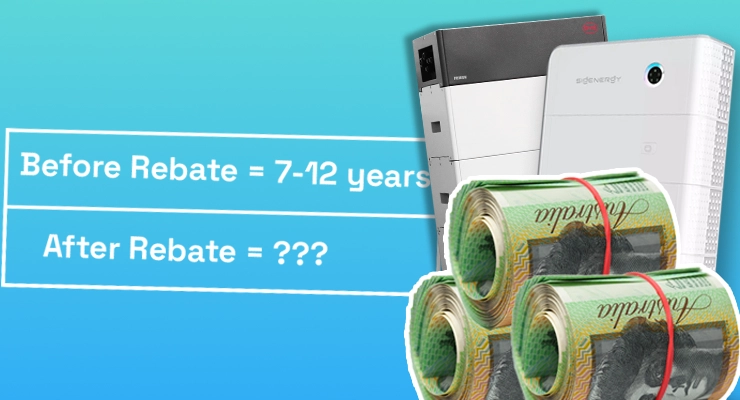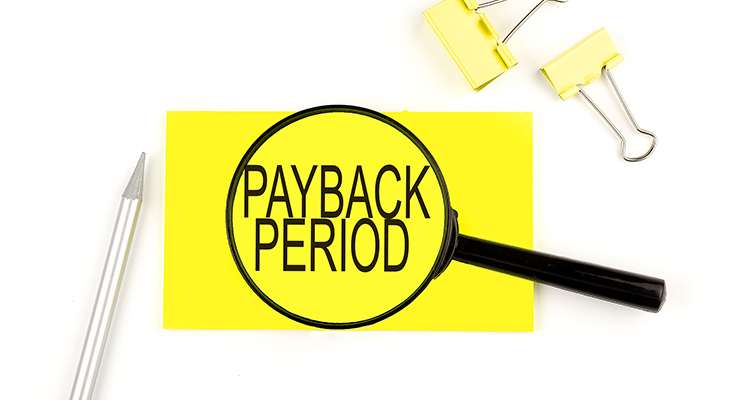Fast read
The typical payback period for a home battery in Australia is between 7 and 12 years without any rebates. The federal government's Cheaper Home Batteries Program, starting 1 July 2025, is set to significantly shorten this. With the federal rebate, the return period is expected to fall to a more realistic 6 to 8 years for many households, making batteries a much more financially attractive investment.
What is the typical return period for a battery without and with the Federal Rebate?
For years, the high upfront cost of home batteries has made many Australians question their value. While the benefits of storing your own solar power are clear—energy independence, lower bills, and backup power—the financial return has often been a long-term game. But as of mid-2025, the landscape is changing significantly, primarily due to a major new federal government incentive.
This article breaks down the typical return on investment (ROI) for a home battery, comparing the outlook for a system purchased without a rebate versus one purchased with the game-changing Federal Rebate.
What factors determine a battery’s payback period?
Before we dive into the numbers, it’s crucial to understand what influences how quickly a battery pays for itself. The return period isn’t a single, fixed number; it’s a dynamic calculation based on your specific circumstances.
- Upfront Cost: This is the total price of the battery system, including installation. Prices in 2025 typically range from $900 to $1,200 per kilowatt-hour (kWh) of storage capacity. A standard 10kWh battery, for example, might cost between $10,000 and $12,000 before rebates.
- Electricity Tariffs: The higher the price you pay for electricity from the grid, the more money you save by using your own stored solar power. With electricity prices continuing to fluctuate, the value of self-consumption remains a critical factor.
- Feed-in Tariffs (FiTs): This is the small credit your retailer pays you for exporting excess solar energy to the grid. As Feed-in Tariffs (FiTs) are now much lower than retail electricity prices, there’s a strong financial incentive to store your excess solar energy and use it yourself rather than selling it for a minimal return.
- Your Energy Usage Patterns: Households that use a significant amount of electricity in the evening and overnight (when solar panels aren’t generating) will see the fastest payback. A battery allows you to use your free solar energy during these peak-price times.
The return period for a battery without rebates
Without any government incentives, the financial case for a home battery has been a slow burn. Based on 2025 market conditions, the typical payback period for a solar battery in Australia sits somewhere between 7 and 12 years.
For some households, particularly in areas with lower electricity tariffs or for those with low evening energy usage, the payback period could even stretch towards 15 years, often close to or exceeding the battery’s typical 10-year warranty period. This has understandably made many potential buyers hesitant, viewing batteries as more of a lifestyle and energy security choice than a purely economic one.
How the Federal Rebate Changes Everything
The federal government’s Cheaper Home Batteries Program, launching on 1 July 2025, is a significant development for renewable energy in Australia. The program aims to accelerate the uptake of battery storage by making it more affordable for homeowners and small businesses.
- A Significant Upfront Discount: The program provides a point-of-sale rebate calculated from a base value per kilowatt-hour (kWh) of usable battery capacity. For 2025, this is expected to be around $335-$372 per kWh. For a typically priced system, this rebate should equate to a discount of approximately 30% on the upfront cost.
- Immediate Cost Reduction: For a typical 10kWh battery, this translates into an immediate saving of approximately $3,300 to $3,700. An investment that was $12,000 could instantly become a more manageable $8,300.
- Eligibility Criteria:
- Have a nominal capacity between 5 kWh and 100 kWh (with the rebate applied to the first 50 kWh).
- Be on the Clean Energy Council’s approved product list.
- Be installed by an accredited installer.
- For on-grid systems, be Virtual Power Plant (VPP) capable.
The new return period for a battery with the Federal Rebate
By slashing the initial investment, the federal rebate dramatically shortens the time it takes for a battery to pay for itself.
With the rebate applied, the average payback period is expected to drop significantly into a range of 6 to 8 years. While a faster payback of around 5 years may be possible under ideal conditions (high evening usage, specific electricity tariffs), most households in major capital cities should expect a return within that 6-to-8-year window. Some analyses suggest it could be longer in cities with lower electricity tariffs, like Melbourne and Canberra.
Can the Federal Rebate be combined with other incentives?
The ability to combine the federal rebate with other state and territory incentives depends on local rules. It cannot be stacked with all state-level hardware rebates. For example, the New South Wales hardware rebate ends when the federal program begins on 1 July 2025, so they cannot be combined. However, in Western Australia, the federal rebate can be combined with the existing WA state hardware rebate, offering residents an even greater discount.
Another powerful way to improve your return on investment is by joining a Virtual Power Plant (VPP). A VPP is a network of connected home batteries that can be drawn upon to help stabilise the electricity grid. In return for allowing a VPP operator to use a small portion of your stored energy, you earn credits or payments. The federal rebate is designed to be used alongside VPP participation, further accelerating your battery’s payback period.
The final verdict: Is a battery worth it in 2025?
Without a rebate, a home battery remains a long-term investment, best suited for those prioritising energy independence and backup power over fast financial returns. The payback period of 7-12 years is viable but requires patience.
However, with the introduction of the Cheaper Home Batteries Program, the equation has fundamentally changed. A potential payback period of 6 to 8 years makes a home battery a financially sound decision for a broad range of Australian households. It allows you to maximise the value of your solar system, protect yourself against fluctuating electricity prices, and gain greater control over your energy future—all while paying off your investment in a much more reasonable timeframe.
If you’ve been considering a battery, the launch of the federal rebate from 1 July 2025 presents the strongest financial case Australia has ever seen. To understand your specific return on investment, getting a tailored quote that accounts for your Energy Usage Patterns, local electricity rates, and eligibility for all available incentives is the essential next step.





